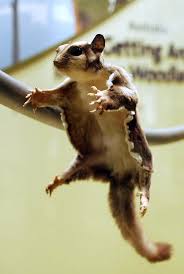
Most birds fly. So do insects and bats. But did you know that some squirrels, lizards, frogs and snakes have also taken to the air?
Remember Dumbo the flying elephant? And we all know about all those wonderful things which might happen when pigs fly. Well, take a stroll in the jungles of Borneo next time you’re passing that way. You won’t – unless you’ve had a drop too much of the local date brandy or palm wine – see pigs and elephants defying gravity but you could well see a squirrel gliding thought the air.
Soaring squirrels
The aeronautical squirrel – address him as Petauristinae if you’re feeling formal – lives with his mate in a hole high up in some tall tropical tree. He’s a handsome guy wearing a rich russet fur coat which looks as if was bought for a bigger chap. In the late afternoon he and his wife scamper out for a bit of exercise – running along the bark using their needle sharp claws like rock climbers’ pitons.
Then they begin to circle the tree trunk frenetically, Suddenly and quite unexpectedly the pair of them take off, first one and then the other like a two part squadron. Together they glide effortlessly and silently up to 35 yards through the air toward the next tree. During the flight all four limbs are stretched out tightly and the baggy overcoat reveals itself as a useful flat membrane attached at wrist and ankle.
They have evolved fairly light bones and their ‘flight’ is a way of moving from tree to tree in a dark forest hundreds of feet below the leafy canopy where the long trunks are straight and lower branches are few and far between. It’s really more of a supported jump – similar to hang gliding – than to true flight.
The aerodynamics are effective The fat furry tail is a good rudder. So steering looks after itself. Once Mr and Mrs Squirrel are within striking distance of the landing stage they swoop sharply upwards. Thus they hit the trunk running and can gallop away into the forest canopy like aircraft touching down on a vertical runway.
Gliding lizards
In the same forest you might chance on Draco, the flying lizard. His hang-gliding mechanism consists of a couple of neat of flaps of skin which stick out from either flank, furled in like roller blinds against his body. They are stiffened by bony rib extensions evolved for the purpose.
When he gets the flying urge he pulls his ribs forward. That yanks the ribs apart and distends the flaps like and aircraft swivelling its wing flaps. Take-off sends Draco gliding cheerfully from liana to liana and from branch to branch. From underneath the flying flaps look like huge diaphanous insect wings. It’s a lot quicker – and safer because most predators can’t get at you if you’re air-borne – than landing on the forest floor and skittering across to another tree.
Frogs aloft
Keep an eye 0ut for flying frogs too. Not many frogs have parachutes on their feet but Rhacophorus does. Extra long toes mean that the webbing he generally uses for fast swimming has evolved to be much larger than that of his common-or-garden froggy cousins.
When he leaps he can cover considerable distances because his mega-webbing keeps him air-borne. It means that he can get from leaf to leaf without putting himself at risk or using too much energy as he goes about his amphibian business in the tropical forests of Borneo.
Volitant (now there’s a nice word!) snakes
Chrysopelea, the flying snake, is such a strange beast that for a long time no one believed in him. He was dismissed as a delusion invented by over enthusiastic early explorers. But he’s real enough.
He’s a small, thin, quietish sort of serpent, although very beautiful with greenish- blue scales flecked with gold and red. Most of the time he whizzes skilfully up and down vertical tree trunks at top speed.
When he fancies piloting himself across to another tree for a change of scenery he races along a branch and throws himself off. In the air he flattens his body like a piece of ribbon which catches the air and enables it to travel much further than if it just fell. The physics are neatly evolved because most snakes’ bodies are cylindrically rounded. In ‘flight’ or glide the snake wriggles his flat length into a series of curly coils which gives him a bit of control over direction and landing site.